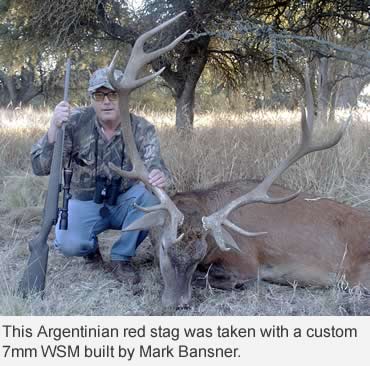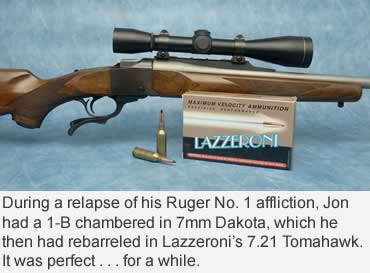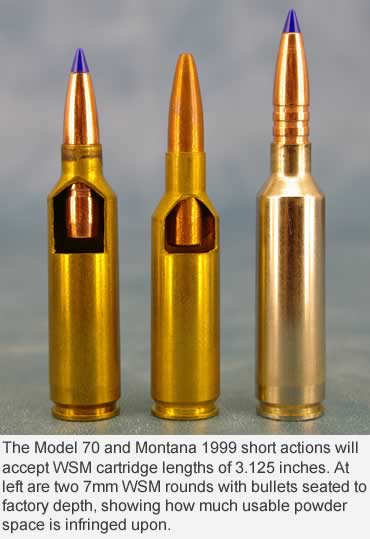By Jon R. Sundra
Planning for the next hunting gun never gets old.
Photo: The 7mm WSM from Montana Rifle Co., a near clone of the Model 70, represents the author’s current ideal hunting rifle. Jon also has a nearly identical model and two other similar guns stocked in wood laminates.
Does it exist? The perfect rifle, I mean. The answer is yes, but only for each of us and often only for a moment in time. It depends on how involved we are with guns and hunting.
The average hunter doesn’t read magazines like this one, and has little interest in new rifles and cartridges. For the most part, he is content with whatever rifle or shotgun he has, as long as it suits his needs and performs to his expectations.
Like him, many hunters look forward to opening day but put away their rifle or shotgun at the end of the season.
Then there are avid hunters who have an abiding interest in new guns, ammo and related items and are experienced enough to have their own opinions. With that knowledge comes the ability to change those opinions based on a different perception and/or new technology.
 I recall a conversation I had with Jack O’Connor. He confided that he regretted being so closely associated with the .270 Winchester because he liked the .30-06 just as well and the then-new 7mm Remington Magnum even better. His readers reacted negatively when his praise strayed to calibers other than the .270. So I learned rather early on that we gun writers aren’t allowed to change our minds!
I recall a conversation I had with Jack O’Connor. He confided that he regretted being so closely associated with the .270 Winchester because he liked the .30-06 just as well and the then-new 7mm Remington Magnum even better. His readers reacted negatively when his praise strayed to calibers other than the .270. So I learned rather early on that we gun writers aren’t allowed to change our minds!
There is nothing as constant as change, however. And like O’Connor, my perception of the ideal rifle and cartridge has certainly changed over the years.
I grew up on the east side of Cleveland, Ohio. My dad was not a hunter, so it wasn’t until I got a driver’s license and my own car that I gained the independence to get out into farm country where my two buddies and I could hunt squirrels and groundhogs on our own.
The Marlin bolt-action .22 magnum I was using proved marginal for big woodchucks beyond 80 to100 yards, so I graduated to my first centerfire rifle: a Marlin Model 62 Levermatic in .256 Winchester Magnum.
Originally designed as a pistol cartridge, it was based on a .357 Magnum necked down to .25 caliber. It pushed a highly inefficient 60-grain bullet at a blistering 2,760 fps. It was more than enough for the relatively small farms I hunted, where 150 yards was a long shot. I thought it was the perfect gun for the hunting I was doing.
 When I moved to Columbus to attend college, I discovered the .256 wasn’t nearly as adequate for the much larger farms of central Ohio. In searching for new hunting areas, I made the acquaintance of a guy about my age whose dad owned one of the farms. Like me, he was a rifle weenie and handloader. His rifle was a Winchester Model 70 in .220 Swift.
When I moved to Columbus to attend college, I discovered the .256 wasn’t nearly as adequate for the much larger farms of central Ohio. In searching for new hunting areas, I made the acquaintance of a guy about my age whose dad owned one of the farms. Like me, he was a rifle weenie and handloader. His rifle was a Winchester Model 70 in .220 Swift.
It didn’t take long to see that my little .256 Marlin couldn’t compete with my friend’s Swift, so I picked up a Remington 722 in .257 Roberts in a pawn shop. It was what I considered my first real big game rifle. After using it in the field only once, I had it rebarreled to .22-250 — then still a wildcat — and glass bedded it into a Herter’s Monte Carlo stock with a roll-over cheekpiece (rollovers were all the rage back in the ’60s), and fitted it with a cheap 3-9x scope. As a student whose hunting was limited exclusively to groundhogs, I thought that .22-250 was the perfect rifle for me at the time.
After graduating, I booked my first Western hunt for mule deer a year in advance, on the assumption I would have an honest job by then. Non-teaching jobs for someone with a degree in English literature were pretty scarce back then, but I eventually found employment and began planning for my next perfect rifle.
Because deer and groundhogs were now on my agenda, I figured I needed a dual-purpose rifle, a concept that was very popular back then, thanks to the .243 Win and 6mm Rem cartridges.
Arguments over which cartridge was superior raged in the gun magazines of the day. But for the same reason I went with the .22-250 over the .220 Swift, I chose the recently renamed 6mm Rem over the much more popular .243 Win. I had concluded this reincarnation of the old .244 Rem was superior to the .243, especially if built on a standard-length action, which would allow seating longer, heavier bullets out where they belong.
 Even though I was only in my mid-20s at the time and had little empirical knowledge, I had already developed strong opinions about rifles, cartridges, stocks and scopes based on obsessive reading and research. I was already to the point where no major rifle manufacturer made the exact gun I wanted. So I did what I’ve been doing ever since when it comes to most of my personal rifles: I built one by choosing an action, having it barreled and chambered to my specs, and then stocking, glass bedding and finishing it myself.
Even though I was only in my mid-20s at the time and had little empirical knowledge, I had already developed strong opinions about rifles, cartridges, stocks and scopes based on obsessive reading and research. I was already to the point where no major rifle manufacturer made the exact gun I wanted. So I did what I’ve been doing ever since when it comes to most of my personal rifles: I built one by choosing an action, having it barreled and chambered to my specs, and then stocking, glass bedding and finishing it myself.
I went with a Santa Barbara commercial Mauser action, had a Douglas barrel of medium sporter contour chambered in 6mm Rem fitted, and set it into a Fajen Regent stock.
For the next two years, that 6mm served me well on hunts for mule deer, antelope, bear in Ontario, exotics in Texas, as well as for varminting and predator calling.
It was my idea of the perfect rifle, but time changed that. I found myself planning a caribou hunt in Labrador and an elk hunt in Colorado. I thought my 6mm would be out of its league, so I proceeded to build not one but two identical rifles, one in .25-06, the other in 7mm Rem Mag.
Both were based on Sako OEM barreled actions which I set into Fajen’s Regent stocks. The only difference between the two guns was that the 7mm Mag was in an all-walnut laminate, while the .25-06 wore a walnut/maple laminate. Wood laminated stocks were just becoming available and were not yet popular. I embraced them because I knew they were far stronger and more stable than the traditional one-piece walnut stock. I figured I had the perfect North American rifle for everything but the big bears.
That lasted only a couple of years. Then I became hopelessly enamored with the Ruger No. 1, specifically the Model 1-B. For several years, on every hunt I could use my own rifle, I carried a No. 1. My first African safari was with two No. 1s, one in 7mm mag, and one in my wildcat .375 JRS. On the next two safaris, my heavy gun remained the No. 1 in .375 JRS. I was determined to collect Africa’s Big Four using a single-shot rifle, but after some hairy moments with a lion, a buffalo, and an elephant, I saw the light and went back to my beloved bolt action.
 By the late '70s I had become disenchanted with the belted magnum case, so I built up a .280 Rem, followed by “improved” versions — the .280 RCBS and .280 Ackley Improved. I thought I could improve on both of those wildcats, so I designed one of my own called the 7mm JRS, also based on an improved .280 case.
By the late '70s I had become disenchanted with the belted magnum case, so I built up a .280 Rem, followed by “improved” versions — the .280 RCBS and .280 Ackley Improved. I thought I could improve on both of those wildcats, so I designed one of my own called the 7mm JRS, also based on an improved .280 case.
A favorite rifle in that chambering had a Remington 700 action, an E.R. Shaw barrel and a Fajen all-walnut laminated stock in classic configuration. I used that gun almost exclusively for non-dangerous game until the mid-1980s. When I replaced it, it was with another 7mm JRS, this one based on a Sako action, another E.R. Shaw barrel and a McMillan fiberglass stock. That gun remained my perfect rifle until the early ’90s, when Dakota introduced its line of proprietary cartridges based on the beltless .404 Jeffery case.
Having a relapse of my Ruger No. 1 affliction, I had a 1-B rebarreled to the 7mm Dakota, then rebarreled again to Lazzeroni’s 7mm short magnum. Both had very similar ballistics, and in retrospect I still don’t know why I switched out what was a perfectly good Dakota barrel for one chambered in the 7.21 Tomahawk, but I guess that’s what gun writers do simply because we can. Needless to say, each of the aforementioned was my idea of the perfect rifle/cartridge at the time.
Which brings me to the here and now. Ever since Winchester introduced its 7mm WSM back in 2002, I’ve thought it the perfect 7mm cartridge. Here was a readily available beltless case with the ideal capacity, given today’s handloading propellants. To handle this perfect cartridge is the Winchester Model 70 short action. Unlike other short actions, this one can accommodate an overall cartridge length of 3.125 inches. This makes it, along with the Montana Model 1999 action, unique.
Handloaders can seat out the heaviest bullet so it does not infringe on usable powder space. This provides more velocity than factory rounds, which must be kept to a 2.8-inch overall length.
I currently own two such rifles. One, based on a Model 70 action, is by Mark Basner and wears his fiberglass stock. The other is based on a Montana action set into a McMillan Edge stock. Considering that both guns have different actions, barrels and stocks, they are about as identical as two different guns can be.
So what’s the next perfect rifle for me? I don’t know yet. It depends on what the future holds in the way of new guns, actions and/or complete rifles, and new cartridges. So far, I have yet to opt for an action with a detachable magazine, but they are getting better and better all the time. It may be an option I’ll choose for my next project.
It also depends on new trends in stock shape and composition, as they, too, continue to evolve.
All I know for sure is that planning for the next perfect rifle is something that never gets old because perfection, if attainable at all, lasts only for a while.
Read Recent GunHunter Articles:
• King of the Quarter Bores: The .257 Weatherby is a good alternative to the hard-thumping .30-cal. magnums.
• A Wild Hog Sledgehammer: The stout .45-70 cartridge is bad medicine for big pigs.
This article was first printed in the September 2011 edition of Buckmasters GunHunter Magazine. Subscribe today to have GunHunter delivered to your home.